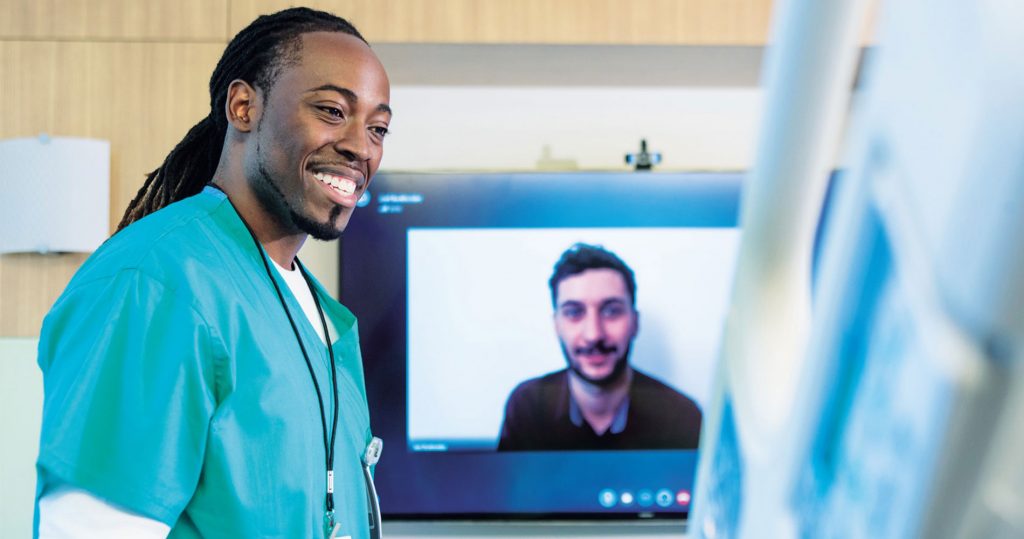
What we can learn from the healthcare innovation of the last year
The world looks very different from a year ago. What started out as a month-long lockdown, turned into a year that’ll be remembered for the sudden change in the lives of almost every single person on the planet. The way we live, learn and work has changed forever, and no sector has felt that change more than healthcare.
Healthcare companies, hospitals, doctors, and patients have need to work in a completely new way. Often, far removed from their patients.
But even before the pandemic, innovative healthcare providers in developing countries like Pakistan were already making moves to deploy powerful digital solutions to address challenges like a shortage of doctors and lack of access to quality medical services.
According to international management consultancy Roland Berger, tech solutions like telemedicine, and more specifically, e-consultations have been around for more than a decade in some GCC countries. E-health monitoring, such as the remote collection and analysis of data via glucometers and blood pressure readers, has also become more common place in recent years. In fact, more than 50 percent of hospitals in the United Arab Emirates are using IoT-enabled solutions and about 90 percent of doctors provide medical care via their smartphones.
The global events of the last year have put a spotlight on these and other tech solutions, and there have been several great case studies to learn from when it comes to deploying these tools during a crisis.
Remote connections
Healthcare provider Sehat Kahani is an example of an organisation that saw a need to address healthcare challenges in Pakistan with the help of technology long before COVID-19.
According to Sehat Kahani’s co-founder and CEO Dr Sara Saeed, half the population of Pakistan will never visit a doctor in their lifetime and one in five children will not make it to the age of five. At the same time, the health system struggles to retain doctors. Of the 150,000 that graduate each year, two-thirds are women who often leave their careers to raise children. This is what Dr Saeed calls the “doctor-bride phenomenon”.
Hoping to address Pakistan’s healthcare challenges and encourage these qualified doctors back into medical practice, Dr Saeed turned to technology. Sehat Kahani was established in 2017 and sought to connect patients in underserved communities throughout the country with female physicians based at home. Video conferencing capabilities allowed these doctors to conduct virtual consultations with patients at ICT-enabled clinics around the country. In addition, platforms like Microsoft Azure makes storing and accessing patient records from anywhere simple. This centralised system allows doctors to easily access their patient’s history no matter their location and patients don’t have to visit the same clinic for their details to be available.
Since its founding, Sehat Kahani has created a network of 5,000 female doctors who are supported by 150 community health workers at 32 e-health clinics throughout Pakistan. In addition, the organisation launched an app to provide greater access to its services via smart phones. This has proven to be a useful tool during COVID-19 to diagnose symptoms and direct patients to a facility for care and treatment.
However, once there, treating COVID-19 positive patients while keeping doctors and nurses safe has been tough to navigate. As of 15 August 2020, some 300,000 healthcare workers have been infected with COVID-19 globally.
To reduce physical exposure to COVID-19 positive cases, Rambam Hospital in Israel collaborated with Rafael and Microsoft to develop a system of virtual consultations within the hospital. Dubbed Rstream, the solution combines the capabilities of cloud and artificial intelligence (AI) to transmit medical information from anywhere securely. Cameras have been installed in front of medical devices and connected to the hospital’s network. Doctors can then access a live stream of a patient’s monitor via an app on their phone and check vitals remotely.
Paving the way for health innovations
While the pandemic has meant more physical distance than we ever expected, it has also fostered an environment for technology to be used in innovative ways.
One such example of this is the 24 Hours Holographic Surgery that recently took place in various facilities around the world. Donning a pair of HoloLens 2 mixed-reality headsets, surgeons conducted procedures with the help of holograms and direct links to other surgeons at different hospitals offering additional expertise and guidance. In Morocco, Dr Abderrahim Rafaoui in Casablanca performed a hip procedure and was assisted by Dr Thomas Gregory in Paris, while Dr Belkacem Chagar in Rabat was joined by Dr Jaber Alkhyeli in Abu Dhabi for a knee operation.
Microsoft’s HoloLens 2 device is also helping to address training needs during the pandemic with the help of Dynamics 365 Guides. At the Israel Center for Medical Simulation (MSR) and Sheba Medical Center, instructors are using the mixed-reality headsets and virtual tutorials to train staff on how to use various medical devices. Students receive hands-on experience with the equipment as an instructor and hologram prompts guide them remotely.
Many similar projects and healthcare solutions are enabled by Microsoft Cloud for Healthcare, which was recently launched to meet the ever-changing needs of medical professionals. With the help of an array of features, doctors and nurses can achieve higher levels of collaboration, gain more insights through data, and increase patient engagement, all while protecting patient privacy securely in the cloud.
As telemedicine becomes the norm, the recent holographic surgeries offer only a glimpse of what’s to come. It’s through the consistent use and widespread adoption of technology that we’ll see new and exciting advancements in healthcare. The goal? To be able to provide greater access to quality medical services for all.










![A security team analyses key data from a visual dashboard.]](https://news.microsoft.com/wp-content/uploads/prod/sites/133/2023/04/Security-Sprint_TL_Banner-Image-519x260.jpg)



